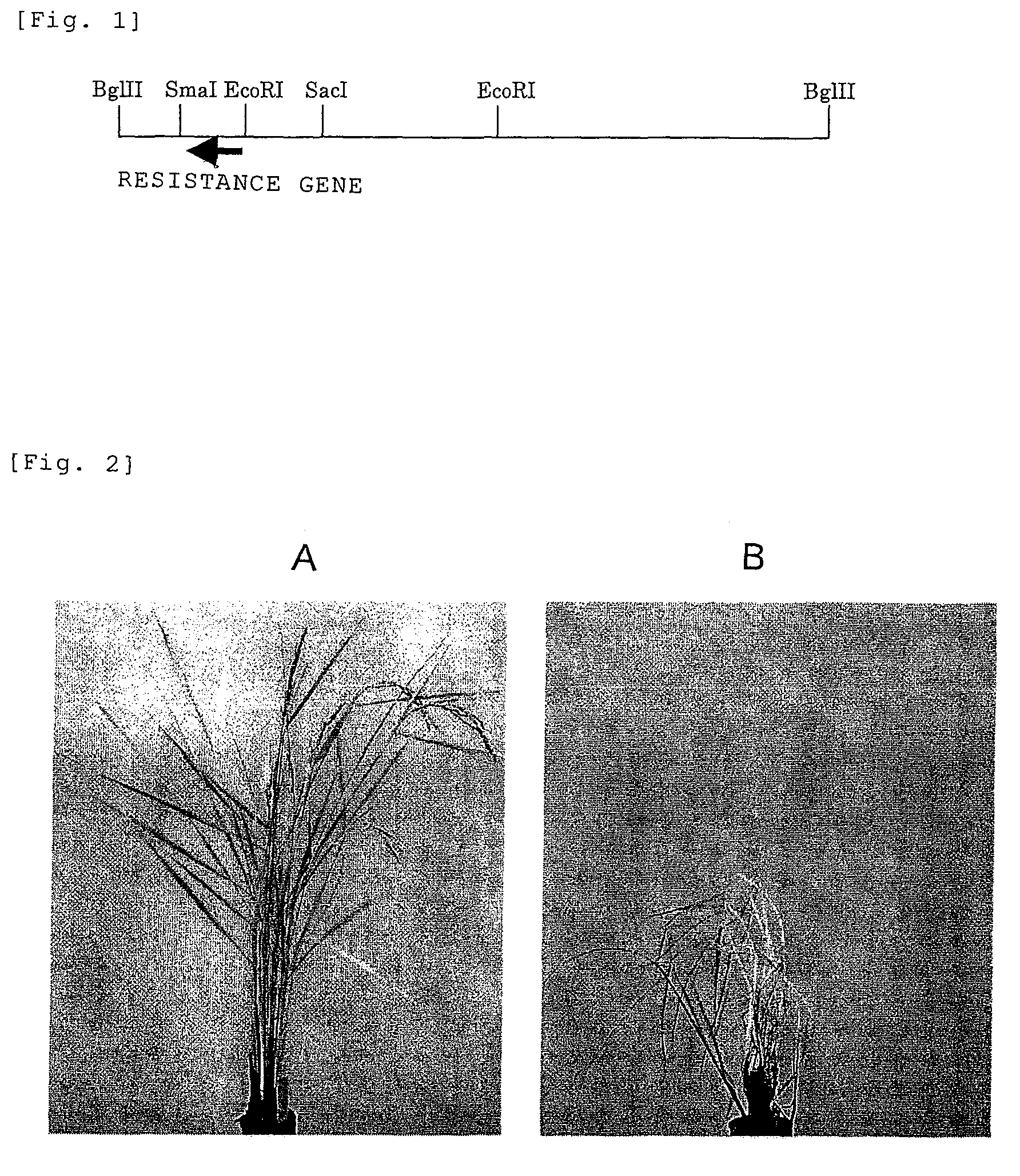Herbicide-resistance gene and utilization thereof
a technology of resistance gene and resistance gene, applied in the field of resistance gene and utilization thereof, can solve problems such as plant death
- Summary
- Abstract
- Description
- Claims
- Application Information
AI Technical Summary
Benefits of technology
Problems solved by technology
Method used
Image
Examples
example 1
Cloning of a Herbicide-Resistance Gene
(1) Screening of Herbicide-Resistant Bacteria
[0061]Actinomycetes (about 500 strains) stored by the applicant of the present invention were inoculated into a selective medium containing bialaphos and cultured at 27° C. for 7 days, and then the growth conditions of the respective bacteria were investigated. The selective medium is an agar medium prepared by pouring 20 ml of a medium obtained by adding 50 mg / l of bialaphos to a medium having the composition of 1% glucose, 0.2% L-asparagine, 0.03% NaCl, 0.05% MgSO4.7H2O, 0.5% (V / V) a trace element solution (a solution of 40 mg of ZnCl2, 200 mg of FeCl3.6H2O, 20 mg of CuCl2.2H2O, 20 mg of MnCl2.4H2O, 20 mg of (NH4)6Mo7O24.4H2O, 20 mg of CoCl2.6H2O, and 100 mg of CaCl2.2H2O in 1 L of water), and 1.8% Bacto-agar into a plastic petri dish with a diameter of 9 cm, and solidifying the medium.
[0062]As a result, AB3534 strain was selected as a bacterial strain capable of growing on the selective medium. The...
example 2
Introduction of Herbicide-Resistance Gene into Plant Cell
(1) Construction of a Vector for Introduction of a Plant Gene
[0087]In order to express the herbicide-resistance gene derived from Streptomyces sp. AB3534 strain in plant cells, PCR was performed using primers having the sequences represented by SEQ ID NOS: 4 and 5 to amplify the herbicide-resistance gene. The reaction solution was prepared by adding water to 5 μl of Takara ExTaq Buffer×10 solution, 4 μl of dNTP mixture, 30 ng of a template DNA, 1 μl each of primer solutions, and 0.5 μl of Takara ExTaq to a total volume of 50 μl. The reactions were performed under conditions of 35 cycles of 94° C. for 30 seconds, 60° C. for 30 seconds, and 72° C. for 45 seconds.
[0088]After the reactions, PCR fragments were purified using GeneClean. Restriction enzymes XbaI and SacI (0.5 μl each) and T buffer×10 solution (2 μl) were separately added to the purified PCR fragments and a vector for transforming plant cells, pBI221 (manufactured by ...
PUM
| Property | Measurement | Unit |
|---|---|---|
| pH | aaaaa | aaaaa |
| diameter | aaaaa | aaaaa |
| diameter | aaaaa | aaaaa |
Abstract
Description
Claims
Application Information
 Login to View More
Login to View More - R&D
- Intellectual Property
- Life Sciences
- Materials
- Tech Scout
- Unparalleled Data Quality
- Higher Quality Content
- 60% Fewer Hallucinations
Browse by: Latest US Patents, China's latest patents, Technical Efficacy Thesaurus, Application Domain, Technology Topic, Popular Technical Reports.
© 2025 PatSnap. All rights reserved.Legal|Privacy policy|Modern Slavery Act Transparency Statement|Sitemap|About US| Contact US: help@patsnap.com

